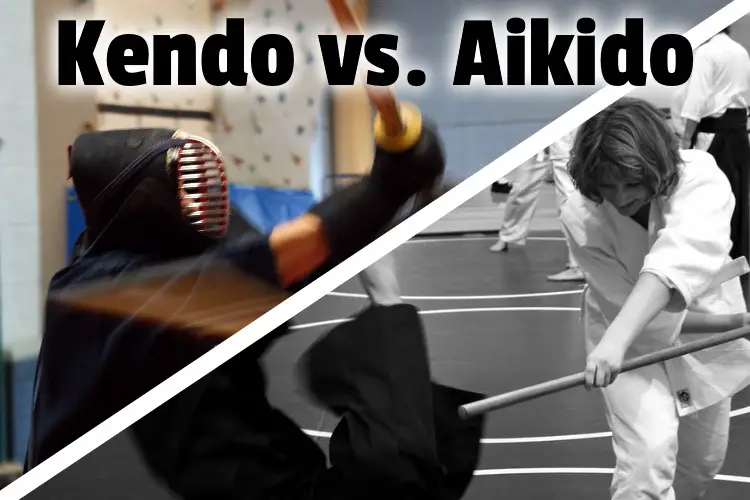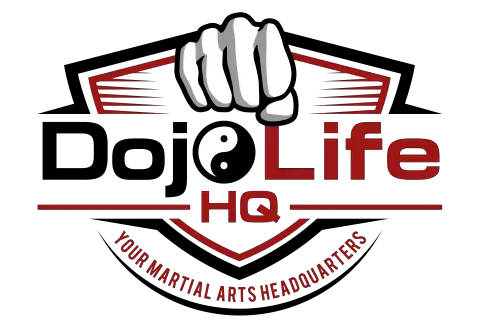
Kendo and Aikido are both highly popular Japanese martial arts. But what sets them apart? How are they similar, and what are the key differences between Kendo vs. Aikido?
Here’s what I’ve noticed:
Kendo is a hard martial art focused on swordsmanship, while Aikido is a soft martial art with a do-no-harm ethos. In hard martial arts, brute force is a defining element. But soft martial arts are more about strategy and using an opponent’s energy against them.
And Aikido does sometimes use the wooden sword called a bokken, just as Kendo does.
But, there’s a lot more to know.
In this article, we’ll find out whether Kendo and Aikido are hard or soft martial arts. We’ll discover if Aikido is really useless. But we’ll also find out if Kendo uses a belt system like other martial arts.
Let the fun begin.
A Japanese Martial Art, Kendo. #Japan #history pic.twitter.com/eezMPL0dWy
— Snakku (@Snakku) March 8, 2016
Are Kendo and Aikido hard or soft martial arts?
Kendo is a hard martial art. Aikido, on the other hand, is a soft martial art. Hard martial arts oppose force with force. They are a blend of technique and brute force, while soft martial arts are about leverage and technique. They are about smarts — using the opponent’s strength against them.
Aikido is a unique martial art in that it’s about fostering peace and harmony.
Practitioners believe that when we harm others, we’re also harming ourselves. It’s not about overcoming an opponent, but it’s rather about self-perfection.
That’s not to say that it’s ineffective.
It’s considered a soft martial art because its thrust is defense. When an assailant attacks, one of the ways an Aikidoka responds is by using their momentum against them, by throwing them.
Unless the attacker is trained on how to break a fall, this can have a devastating effect.
It’s an art that employs deflection and redirection. Of course, there are many other techniques that are used. But at its highest level, it’s about preventing a confrontation and ensuring there’s harmony. Aikido is arguably the most spiritual martial art.
Tai Chi is also an example of a soft martial art.
Kendo is a hard martial art. As such, it is not about deflection and redirection. Strikes and thrusts are aimed directly at specific parts of an opponent’s body.
A Kendoka is alert and ready to defend and attack at any moment, and they score points when the strikes and thrusts hit the target. They are also required to call out the part of the body their sword hits and stomp their foot. It’s a way of meeting force with force.
But, like Aikido, it has a spiritual focus too.
The Japan Kendo federation states that “Kendo is a way to discipline the human character through the application of the principles of the Katana (the standard Japanese sword).”
Kung Fu, Karate, and Taekwondo are also examples of hard martial arts.
Kendo is Japanese fencing. You’ve probably wondered about how it differs from Western fencing. A recent article of mine is an exploration of the crucial differences between Kendo and fencing.
In it, I looked at whether fencing is like sword fighting and if Kendo is good for self-defense. I even offered advice on whether to choose fencing or Kendo.
Just click the link to read it on my site.
#martialartsmailcall Today’s book is #Aikido: The Contemporary Martial Art of Harmony by Ueshiba Moriteru, the grandson of Ueshiba Morihei. I bought this book as a print replica for my Kindle, which means it’s really a PDF underneath the packaging. pic.twitter.com/go0mXfhsP1
— Martial History Team 📔 (@martialhistoryt) July 5, 2021
Is Aikido really useless?
Aikido is not useless. The notion that it is stems from the fact that it’s often compared to intense martial arts. The truth is it is highly effective when properly understood and employed.
It’s a soft martial art where the focus is not on brute force but rather on using an assailant’s energy and momentum against them.
Another factor that fosters the notion that it is useless is that it’s possible that its self-defense aspects are not being stressed as much as they should in some dojos.
And there’s not much sparring being done in many dojos.
When taught properly, it can be highly efficient. It’s a smart way to subdue an opponent. But it’s also limited in scope compared to some other martial arts such as Karate, Kung Fu, or Krav Maga.
Relative to these, it looks tame, in fact, lame to some (not to me).
One thing that also makes people a tad suspicious of its effectiveness is the fact that it seeks to foster peace and harmony.
This is aptly captured in one of the sayings of the founder, Ōsensei:
“Aikido does not rely on weapons or brute force to succeed: instead we put ourselves in tune with the universe, maintain peace in our own realms, nurture life, and prevent death and destruction. The true meaning of the term samurai is one who serves and adheres to the power of love.”
Aikido may seem woo-woo for folks who want a martial art they can rely on if they were ever jumped in a dark alley.
But if you’re interested in a martial art that’s highly spiritual, look no further.
You can deepen your understanding of Aikido by checking out a recent article of mine. In it, I explored its philosophy. But I also take a deep dive into the founder, Morihei Ueshiba, sometimes called Ōsensei.
Then I explored what he believed in and whether he was knowledgeable about other martial arts. And whether it’s the most peaceful martial art.
Just click the link to read it on my site.
6th Kyu grading for Kendo today – Let’s see what I’ve learnt within the last under-a-month! pic.twitter.com/H6qzWMHJFR
— Deathborn_ (@EhsanH06) February 9, 2019
Does Kendo use a belt system?
Kendo does not use a belt system. But practitioners are ranked and tested when they are deemed competent enough. Then, they progress from one level to another. There are two main ranks: Kyu and Dan. Naturally, there are gradations in each level that are indicative of the practitioner’s level of proficiency.
In addition to the two ranks, titles (shogo) can be earned. But, there are no outward signifiers of rank. So, an advanced kendoka and a rank beginner would look exactly the same.
The ranking system is structured, and it reflects a practitioner’s level of competence (kenshi).
The Kyu being the most basic. It has 6 levels, and one starts at the 6th and progresses upward. The Kyu is followed by the Dan. It has 8 levels. In the Dan stage, one starts from the 1st level and gradually proceeds to the 8th.
There are regulations set by the International Kendo Federation. These spell out the requirements for examinations practitioners have to pass to proceed from one rank to another.
Exams for kyu levels are usually administered internally by kendo clubs, while those of the dan levels are organized by national and international organizations.
Link on https://t.co/8CnFN9GcGq #bokken #schwert #aikido #aikidoschulekoeln #aikidoschuleköln pic.twitter.com/owLPvuJiF5
— Bodo Rödel (@BodoRoedel) January 21, 2021
Is the bokken sword used in both Kendo and Aikido?
The bokken sword is used in both Kendo and Aikido. It’s a wooden mock-up sword that is also used in other Japanese martial arts as well. It is often shaped like a Katana (a curved sword with a single edge). And it can be gripped with both hands.
At times, it’s shaped like other Japanese swords, such as the tanto or the wakizashi.
The word bokken means (bok) wood and (ken) sword. It’s shaped like a real Japanese sword, but it’s lighter and has a blunt edge to reduce the likelihood of injuries. But it can still cause harm if not used carefully.
There are different types, and they’re made of different materials.
There are about 100 different types of bokken, each modeled after a real, traditional sword. The “classic” bokken is often employed in Kendo and Aikido, and at times in Iaido.
Preparation for 7th dan Kendo exam.
.
.
.#7thdan #nanadan #zenandbudo #kendo #kendokata #hawaiikendo #臨済宗 #禅寺 #大本山 #超禅寺 #大本山超禅寺 #禅 #chozenji #zen https://t.co/fNub6C4Iqu pic.twitter.com/ol6g148sZl— Chozen-ji (@ChozenjiHawaii) April 21, 2019
How many years does it take to learn Kendo compared to Aikido?
On average, it takes about 2.5 years to learn Kendo, while Aikido takes about 5 years to learn. This is because there are a lot more techniques to learn and master in Aikido. In addition to the myriad techniques to learn, there’s also the philosophy.
But how many years it takes to master either of the martial arts is really a question of how consistent and devoted a person is regarding training.
Those who are really invested almost always make progress faster than those who are not. Just the way it works in other walks of life. There’s a lot to learn in both martial arts, especially in Aikido. This is why it takes a longer time.
In fact, it’s estimated that there are about 10,000 techniques to learn.
And, for all its peaceful ethos, it’s still more realistic than Kendo, which is essentially a form of fencing that’s done with mock-up swords.
And in which the possibility of getting beat up is remote (in fact, it’s non-existent). In Aikido, one has to actually fight. For real. And one can get hurt. Big time.
It’s vital I stress the fact that those who ultimately grasp martial arts are usually not those obsessed with how quickly they can “master” their disciplines. For them, it’s a lifelong journey in which they try to do their best at every opportunity.
Regular practice, they know, is the secret. So, if you ensure that you practice consistently 2 to 3 times each week in a dojo that’s got seasoned instructors, you’ll be golden.
Conclusion
In the article, we found out whether Kendo and Aikido are hard or soft martial arts. We also discovered if Aikido is really useless.
And we found out if Kendo uses a belt system like other martial arts. Then, we considered whether the bokken sword is used in both Aikido and Kendo.
Lastly, we wrapped things up by looking at how many years it takes to learn Kendo relative to Aikido.
Photos that require attribution:
Image by Ananbelle Lee from Pixabay and Allenamento kendo by Luca Mascaro is licensed under CC2.0 and was cropped, edited, merged, and had a text overlay added.
